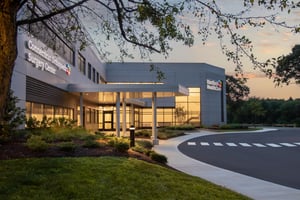What is the engine that has fueled the rise of surgery centers as a key cog in healthcare delivery?...
What Differentiates Cosmetic Surgery Center Design from a Typical ASC?
Designing a cosmetic surgery center requires a delicate balance between functionality, safety, and creating a desirable aesthetic. Whereas ASC's must be separate from other facilities, cosmetic surgery is often integrated within a dermatology clinic, where multiple types of procedures and treatments will be performed in addition to surgery. Unlike traditional surgical centers, cosmetic facilities cater to patients seeking elective procedures to enhance their appearance. The design plays a crucial role in alleviating patient anxieties, creating the right atmosphere, emphasizing the providers' brand, and fostering a sense of trust and well-being. The following aspects of design are unique to these facilities.
Cultivating a Serene, Spa-like Environment:
- Color Palette: A calming and luxurious color palette sets the tone for the entire space. Soothing neutrals like creams, beiges, and light greys, accented with other soft colors, are desirable. Avoid overly stimulating colors that can heighten anxiety.
- Material Selection: Create a sense of warmth and connection to nature by incorporating well-crafted natural materials like wood, stone, and natural fiber accents. These elements not only offer a luxurious feel but also convey a sense of organic beauty.
- Furnishings: Plush, comfortable furniture in the waiting area and consultation rooms promotes relaxation. Incorporate stylish, upholstered chairs and sofas with ample seating space to ensure comfort and privacy.
Artful Touches:
- Artwork and Decor: Carefully curated artwork and decor can significantly enhance the ambiance. Choose pieces that evoke feelings of tranquility, nature, or beauty. Avoid overly personal or graphic elements that may not resonate with all patients.
Illumination:
- Natural Light: Maximize the use of natural light whenever possible. Strategically placed windows can not only brighten the space but also promote a connection to the outdoors, contributing to a sense of well-being. However, ensure appropriate window treatments are incorporated to maintain patient privacy and control light levels when necessary.
- Artificial Light: Select lighting throughout the center thoughtfully. Operating room lighting may be largely utilitarian, but the lighting in other areas of the center must be functional and ambient. The ability to dim lights and lighting directionality help to set the tone. Color temperature and color rendition are important, especially where patients will be looking at themselves in a mirror or where photographs or video will be taken before or after surgery or treatments.
Showcasing Expertise:
- Product Display: Providers often wish to showcase skincare and other relevant products. Sleek and elegant display cases can be integrated into the design to seamlessly integrate product recommendations within the calming environment.
- Branding: Branding plays a significant role in establishing credibility, attracting patients, and fostering long-term relationships for a plastic surgery center. Beyond logos and colors, it's about creating a compelling identity that reflects the center's values, expertise, and commitment to patient care.
Functional Considerations:
- Patient Privacy and Modesty must be prioritized throughout the facility. Arrange the plan to control sight lines and carefully segregate patient, staff, and public areas. Utilize frosted glass partitions or privacy screens to ensure discretion while maintaining a sense of openness.
- Zoning and Circulation: Control the flow through the center, separating patient, staff, and public circulation. This not only improves efficiency but also minimizes unwanted interactions and heightens the sense of privacy. A private patient discharge from the surgical suite is often desirable.
- Equipment and Storage: Lasers and other specialized equipment will be used in exam, treatment, and procedure rooms throughout the facility. Ample equipment storage should be provided, whether it be rooms, closets, or well located parking areas. Be sure to consider special power and equipment charging requirements in the design.
Regulatory and Accreditation Issues:
- Ownership and Accreditation: Unlike traditional ASCs governed by the state Department of Health, cosmetic surgery centers are often owned by the practitioners themselves and accredited by independent agencies like Quad A, the American Association for Accreditation of Ambulatory Surgery Facilities.
- Compliance: Depending on whether the facility will be state licensed, it may not be subject to compliance with the FGI Guidelines. However, the design still must comply with state building codes, NFPA 101 (Life Safety Code), accreditation body standards, and other relevant regulations.
- Medicare Coverage: Since most procedures are elective, cosmetic surgery facilities are rarely certified by Medicare, except in cases of reconstructive surgery. Consequently, they do not need to meet Medicare Conditions for Coverage.
- Impact on Design: While regulatory requirements of ASC's are fairly prescriptive, there is more gray area when it comes to cosmetic surgery centers. The design team must work closely with the providers to understand the treatments and procedures to be performed in the facility and together determine the appropriate level of safety, sterility, and functionality for each area of the project.
While cosmetic surgery center design is similar to that of a typical ASC, there are several unique factors that should be taken into consideration. From aesthetic to regulatory concerns, this post outlines many of those factors. Hardaway|Sziabowski Architects designs and consults on cosmetic surgery and dermatology centers. Please contact us using the form below or touching the "Contact Us" button above if we can answer any questions or help you with the design of your next facility.



